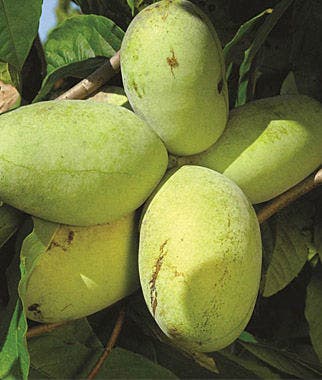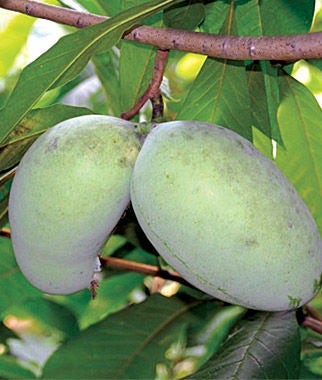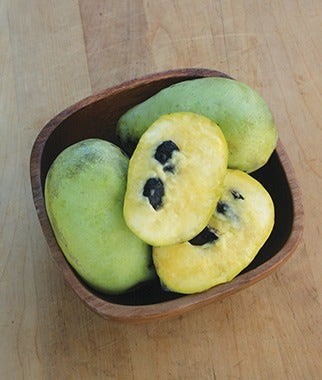We use cookies to give you the best experience on our website. These cookies are completely safe and secure and will never contain any sensitive information. Please read our Privacy Policy. By clicking "Ok" or clicking on any other content, you agree that cookies can be placed.
Pawpaw Fruit

Imagine a tropical-looking little tree with three seasons of interest. Consider such a specimen that also bears banana-like, aromatic and creamy fuss-free fruit in the fall. There is such a special multi-tasking tree and it deserves more attention from gardeners. Sometimes, spectacular plants have yet to be granted their rightful place in our gardens. Meet the pawpaw.
“Pawpaws have interesting, round burgundy flower buds that mature into beautiful burgundy blooms which stand out against bare branches before the tree comes into leaf,” said native plant expert and host of an annual pawpaw tasting in Pennsylvania, Judy Bono, “Pawpaws are also host plants for the zebra swallowtail butterfly.”
They provide food for that beautiful pollinator during the caterpillar stage, and, importantly, sweet fruit for us, she said.
“The tree looks tropical, though it is a native plant in the Northeast and into the Midwest, and it has standout, brilliant yellow foliage in the fall,” said Bono.
What is a pawpaw?
The paw paw is a native fruit and the largest of the North American native tree grown fruits. The nutritional value is very high, rivaling oranges and bananas. The texture is similar to a custard. “Pawpaws taste like a mix of banana, mango with a hint of lemon,” said Bono.
Pawpaws are easy to grow and grow quickly. Since they are native, they are acclimated to our soils and weather patterns. In nature, they are understory trees, or they grow under taller trees. They enjoy soil rich with organic matter and are often found along creeks or streams. That said, they don’t grow as well in soil that isn’t well drained. They like full sun but can tolerate some shade. While rapid to grow, the tree needs to mature before bearing fruit.
Using Pawpaw Fruit in Food
 Since the tree grows wild in the U.S., the fruit has played a role in our history. George Washington’s favorite dessert was chilled pawpaw and Lewis and Clark subsisted on pawpaw at times during their journeys. As the fruit ripens in September, the fragrance of the fruit fills the air and creates a seasonal olfactory experience in the garden. All of the fruit comes on within a two-week period. The fruit has not been widely cultivated, in part, because it has a very short shelf life, said Bono.
Since the tree grows wild in the U.S., the fruit has played a role in our history. George Washington’s favorite dessert was chilled pawpaw and Lewis and Clark subsisted on pawpaw at times during their journeys. As the fruit ripens in September, the fragrance of the fruit fills the air and creates a seasonal olfactory experience in the garden. All of the fruit comes on within a two-week period. The fruit has not been widely cultivated, in part, because it has a very short shelf life, said Bono.
Bono has discovered several ways to enjoy the harvest. Her go to pawpaw recipes are pawpaw ice cream, pawpaw bread and pawpaw salsa. She suggests utilizing the fruit the easy way.
“Rather than making ice cream from scratch,” she said, “I found it’s just as good to let a half-gallon of vanilla ice cream soften then stir pawpaw pulp into it, about a cup, then let it refreeze.” For breads, she purchases banana bread mixes from the grocery and substitutes paw paw pulp in the same amount as the banana. Make a large batch and freeze the breads. The most difficult part of these recipes is removing the large black seeds from the pulp. She also freezes pulp for later use. Her favorite pawpaw dish is pawpaw salsa.
Pawpaw Salsa Recipe
Peel, seed, and chop 2-3 large pawpaws.
Mix with 1/4 cup green and 1/4 red bell peppers, coarsely chopped.
1 jalapeno, seeded and minced.
2 T. chopped fresh cilantro.
2 T. red onion, chopped.
1 1/2 tsp. fresh lime juice.
1/2 tsp. red pepper flakes.
Chill and serve. She likes to use scoop-type chips to get a good portion.
Benefits of Growing Pawpaw Fruit
The pretty pawpaw tree enhances your garden while helping you fill your freezer with fruit to enjoy into the winter. In fact, the pawpaw is one of the best multi-taskers of native fruit. The pawpaw adds beauty to your garden with lovely flowers, large tropical leaves that brighten fall with brilliant yellow, all while feeding us, and attracting native pollinators to your garden. Adding plants that fill several functions to our landscapes increases enjoyment of nature and of food right at home.



